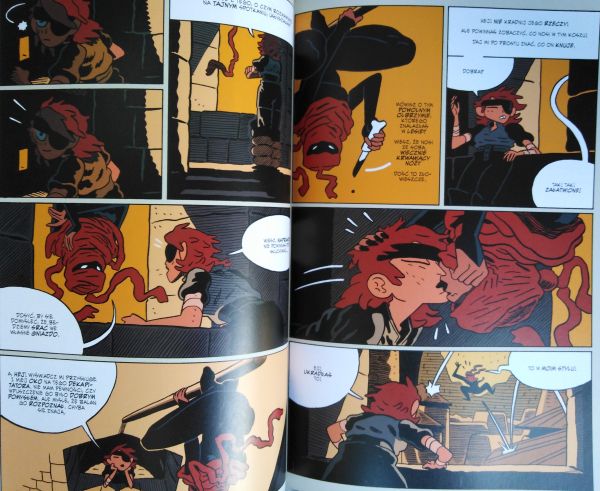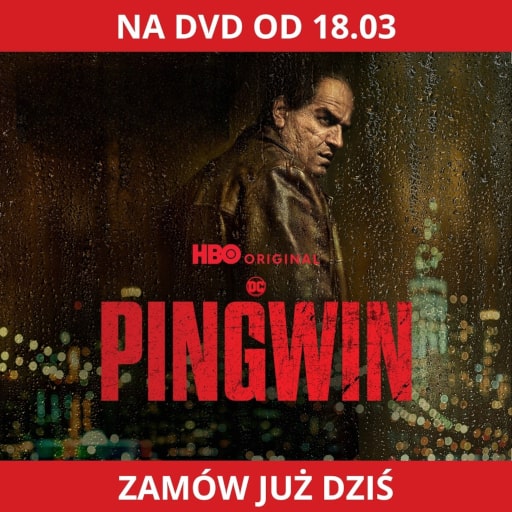Anyone who has read the previous two volumes of Head Lopper knows roughly what to expect in the Knights of Venoria . This is another Norgal adventure full of caricatured creatures, interesting characters, exaggerated action scenes and many spectacular decapitations. If for some reason you would like to start reading from the third album – there are no special contraindications. There are only minor spoilers about earlier events. For the most part, however, the individual parts are independent of each other, and the thread connecting them into a larger whole is still developing.
Srogi archetype
In terms of plot, Head Lopper is still based on a construction known from fantasy classics – the title character arrives in a new place and tries to solve a problem that plagues its inhabitants or is tricked into a local conflict (usually both at once). The decapitator is a taciturn, tired of life and a warrior, bitter master of the sword, who, however, has his heart on the right side and does not hesitate to help others in need. I have the impression that this is how Geralt of Rivia could have looked if Andrzej Sapkowski had continued writing the witcher’s adventures in the form of short stories and had not invented Ciri’s plot.
Head Lopper and the Knights of Venoria are more than just a reheated cutlet in a new sauce. Maclean realizes that he based the previous two stories on a linear pattern straight from role-playing games. Norgal and the accompanying heroes took turns overcoming obstacles to get to the next “stages” and finally face the “boss”. This time the author decided to throw the hero into the whirlwind of battle chaos and a power struggle straight from Game of Thrones. In the third volume, everything happens very quickly, and the main goals of the characters are to protect the city and survive. In addition, the comic has a lot of flashbacks that shed some light on the past of the Decapitator and Agatha, and also slightly expand the world presented.
Picture fencing
Graphic Head Lopper invariably arouses my admiration. Despite the simplified style and sparing details, Andrew Maclean is able to build credible characters and interesting scenery, and above all – dynamic action. Norgal’s adventures remind me in many ways with Samurai Jack . Both Maclean and Tartakovsky consciously manipulate close-ups and far planes, panning and the pace of the scene. In the comic book about Dekapitator, it makes the impression that the cartoonist, despite operating only with a static image, is able to comprehensively present the readers the speed of the character, the movement of the “camera”, and even the slow motion effect. Sometimes he uses for this purpose a series of slightly different illustrations to accurately show the successive stages of the scene. Other times, quite the opposite – it uses only one frame, guiding our eyes in the direction of the character’s movement. If I were to point out one element in which Maclean’s drawing workshop is imperfect, it would still be the current numbering of frames or the use of arrows indicating which image is next. In the case of such a great artist, it seems to me to take a shortcut and capitulate to the challenge of clearly presenting the action.
The magic of colors
An element of the Head Lopper and the Knights of Venoria that deserves special mention are the phenomenal colors by Jordie Bellaire. Colorists still receive too little attention in relation to the impact they have on the overall comic, as Bellaire herself wrote about a few years ago in an open letter on her Tumblr. In the case of Dekapitator’s adventures, it is enough to flick through the album to see how diverse the palette is. As you read, it becomes clear how important the colors are for the atmosphere of individual scenes, the transparency of the action, the building of the depicted world, and simply the aesthetic value of the comic. In black and white, Head Lopper would not be a series that is half so pleasant to receive. The colorist deserves a standing ovation.
Lightning fast
Non Stop Comics released the third Head Lopper just six months after the album was released in the States. The rapid release of the Polish version, its high quality and much lower price mean that importing the English edition does not make any sense. The translation does not raise any objections, although I am intrigued as to why Jacek Drewnowski decided to change the name of the title city from “Venora” to “Venoria” *. There are also many bonus illustrations and alternative covers for notebook issues at the end of the volume. However, if you are not interested in these types of additions, do not put the comic book off right away. There is a “post-credits scene”!
Andrew Maclean did it again! Jordie Belaire did it again! The NSC people did it again! Norgal did it again! Head Lopper and the Knights of Venoria is another piece of fierce barbaric fantasy in cartoon aesthetics. Yet!
* As it turns out, the error is most likely on the side of the person responsible for editing / proofreading the text, because, as the translator himself explained, the original translation had two names, according to the original – “Venora (goddess, already mentioned in previous volumes) and Venoria (Venoriah , the city where this goddess of worship is to be found, which appeared only in this volume) “. It is hoped that this will be corrected on the occasion of reprints.




